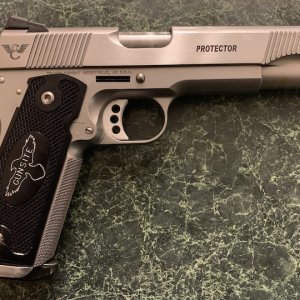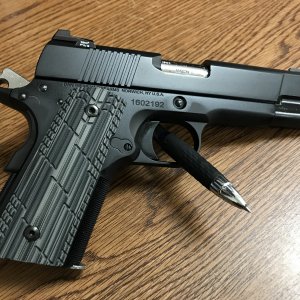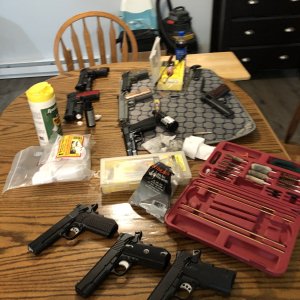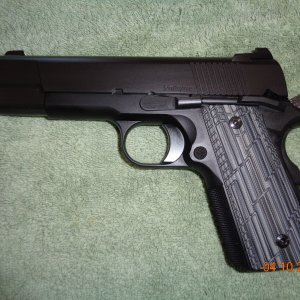Burk Cornelius
Regular guy
October 24, 2019 by Jodi Humann
It seems like there is a dislike for Standard Exercises and Speed Shoots, both from competitors and stage designers. The competitors dislike them because they require following stage procedures, and failure to do so is heavily penalized. Stage designers shy away from them because there are so many rules about designing a legal course of fire. But in reality, these course types can be used to test very specific shooting skills and are great additions to matches if done properly.
I am one of the weird people who likes designing Standard Exercises and Speed Shoots. Why did I develop a love of these technical-type courses? Partially it's because I like the mental challenge of them, even when I shoot them wrong and get a ton of penalties. But the main reason is when I was designing stages for club matches, we had this odd shaped bay with a very limited bullet impact zone and it was hard to put a medium and long course in it, but easy to put a standards or speed shoot.
Yeah, I have heard the argument that these types of courses are all stand and shoot and aren't the same as other courses of fire…but that is the advantage of them! They really are stages where the fleet of foot and slower shooters are evenly tested. They are straight up shooting challenges!
But that being said, you can have some movement in Standard Exercises if they are designed properly (examples are CM 18-01, CM 18-03, CM 18-09). What are the rules for Standard Exercises? See rule 1.2.2.1, 1.1.5.2, and 1.1.5.3 in the USPSA Competition Rules.
The stage design rules for Standard Exercises are:
Two or more strings
Scored as Virginia Count or Fixed Time (so no steel targets)
Can require specific shooting position/location/stance, procedure (e.g. strong/weak hand only), or mandatory reloads
Must not require more than 24 rounds in total for the entire stage
Each string must not require more than 6 rounds, unless a mandatory reload is specified, then the string can be a maximum 12 rounds
After the point strong/weak hand only has been declared, the specified hand must be used for remainder of string
See, just follow these rules and it's simple! Okay, some of you probably don't agree, but you can design some really challenging and interesting stages and test some skills that aren't tested on other stages in the match. We will talk more about that after we discuss Speed Shoots.
Speed Shoots are shorter stages and are covered in rule 1.2.2.3. Again, there are some examples of Speed Shoots in the newer classifiers (CM 18-02, CM 18-05, CM 18-07)
The stage design rules for Speed Shoots are:
One string shot from a single location
Scored as Virginia Count or Comstock (yes, you can have steel when scored Comstock)
Can specify arrays of targets, but competitors must be allowed to engage arrays, and targets within the arrays, in any order
No more than 16 rounds to complete
Stage must not require more than 8 rounds, unless a mandatory reload is specified, then the stage can be a maximum 16 rounds total with a mandatory reload
Weak/strong hand only can be specified after reload
For Level II and higher matches, no more than one speed shoot per every five stages (see 1.2.2.3.1).
Again, there seems like there are a lot of rules, but you can use Speed Shoots to design some challenging stages, that can fit into odd-shaped and smaller bays, and test skills that are not tested by other stages. Strong/weak hand only can be specified for the last 6 shots on medium and short courses (1.1.5.4), but you can't control which targets the competitor engages (hint, smart people choose easy targets). And the only other way to force strong/weak hand on medium and long courses is through props. But, since PCC has been added into the mix, it is much harder to design props that can accommodate handguns and PCCs.
So, the easy solution, is to mix some Standard Exercises and Speed Shoots into the match. Add some strong/weak-hand requirements. Use Virginia Count to limit the number of shots folks can take at each target, versus spray and pray. Change up the number of shots per target from two to one to break up the "shoot 2" auto-pilot. Very simple things can give the match variety, and it doesn't take much work.
Don't want to take the time to design a Standard Exercise or Speed Shoot? Here is an example of each that I designed for my local matches. Throw them into a match and see what happens.
A Standard Exercise – Lewiston StandardsDownload
A Speed Shoot – Cobra VenomDownload
It seems like there is a dislike for Standard Exercises and Speed Shoots, both from competitors and stage designers. The competitors dislike them because they require following stage procedures, and failure to do so is heavily penalized. Stage designers shy away from them because there are so many rules about designing a legal course of fire. But in reality, these course types can be used to test very specific shooting skills and are great additions to matches if done properly.
I am one of the weird people who likes designing Standard Exercises and Speed Shoots. Why did I develop a love of these technical-type courses? Partially it's because I like the mental challenge of them, even when I shoot them wrong and get a ton of penalties. But the main reason is when I was designing stages for club matches, we had this odd shaped bay with a very limited bullet impact zone and it was hard to put a medium and long course in it, but easy to put a standards or speed shoot.
Yeah, I have heard the argument that these types of courses are all stand and shoot and aren't the same as other courses of fire…but that is the advantage of them! They really are stages where the fleet of foot and slower shooters are evenly tested. They are straight up shooting challenges!
But that being said, you can have some movement in Standard Exercises if they are designed properly (examples are CM 18-01, CM 18-03, CM 18-09). What are the rules for Standard Exercises? See rule 1.2.2.1, 1.1.5.2, and 1.1.5.3 in the USPSA Competition Rules.
The stage design rules for Standard Exercises are:
Two or more strings
Scored as Virginia Count or Fixed Time (so no steel targets)
Can require specific shooting position/location/stance, procedure (e.g. strong/weak hand only), or mandatory reloads
Must not require more than 24 rounds in total for the entire stage
Each string must not require more than 6 rounds, unless a mandatory reload is specified, then the string can be a maximum 12 rounds
After the point strong/weak hand only has been declared, the specified hand must be used for remainder of string
See, just follow these rules and it's simple! Okay, some of you probably don't agree, but you can design some really challenging and interesting stages and test some skills that aren't tested on other stages in the match. We will talk more about that after we discuss Speed Shoots.
Speed Shoots are shorter stages and are covered in rule 1.2.2.3. Again, there are some examples of Speed Shoots in the newer classifiers (CM 18-02, CM 18-05, CM 18-07)
The stage design rules for Speed Shoots are:
One string shot from a single location
Scored as Virginia Count or Comstock (yes, you can have steel when scored Comstock)
Can specify arrays of targets, but competitors must be allowed to engage arrays, and targets within the arrays, in any order
No more than 16 rounds to complete
Stage must not require more than 8 rounds, unless a mandatory reload is specified, then the stage can be a maximum 16 rounds total with a mandatory reload
Weak/strong hand only can be specified after reload
For Level II and higher matches, no more than one speed shoot per every five stages (see 1.2.2.3.1).
Again, there seems like there are a lot of rules, but you can use Speed Shoots to design some challenging stages, that can fit into odd-shaped and smaller bays, and test skills that are not tested by other stages. Strong/weak hand only can be specified for the last 6 shots on medium and short courses (1.1.5.4), but you can't control which targets the competitor engages (hint, smart people choose easy targets). And the only other way to force strong/weak hand on medium and long courses is through props. But, since PCC has been added into the mix, it is much harder to design props that can accommodate handguns and PCCs.
So, the easy solution, is to mix some Standard Exercises and Speed Shoots into the match. Add some strong/weak-hand requirements. Use Virginia Count to limit the number of shots folks can take at each target, versus spray and pray. Change up the number of shots per target from two to one to break up the "shoot 2" auto-pilot. Very simple things can give the match variety, and it doesn't take much work.
Don't want to take the time to design a Standard Exercise or Speed Shoot? Here is an example of each that I designed for my local matches. Throw them into a match and see what happens.
A Standard Exercise – Lewiston StandardsDownload
A Speed Shoot – Cobra VenomDownload







